2013 Kawasaki Mule 4010
Test: Kawasaki Mule 4010 Diesel 4X4
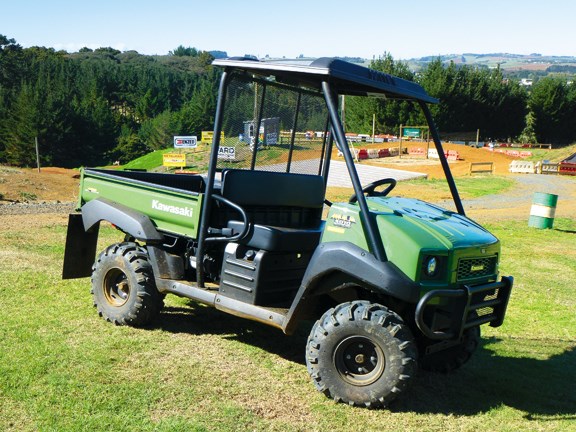 A bench seat with plenty of room for two people and loads of space for cargo in the back
A bench seat with plenty of room for two people and loads of space for cargo in the back 

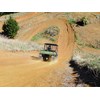
 The four-wheel hydraulic drum brakes manage to provide adequate stopping ability on a downhill
The four-wheel hydraulic drum brakes manage to provide adequate stopping ability on a downhill 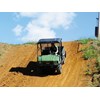
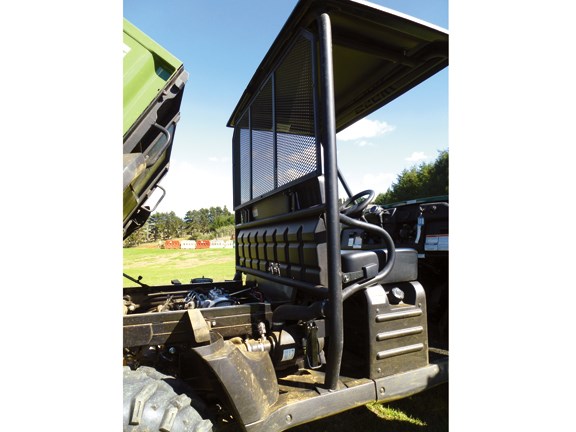 Great idea: the engine draws in clean air through the tubular steel from the top of the roll frame
Great idea: the engine draws in clean air through the tubular steel from the top of the roll frame 
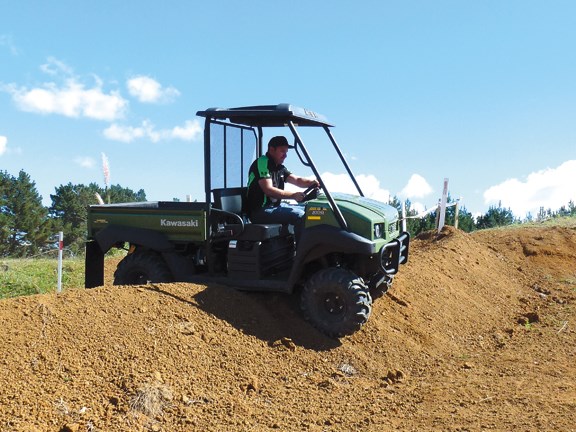

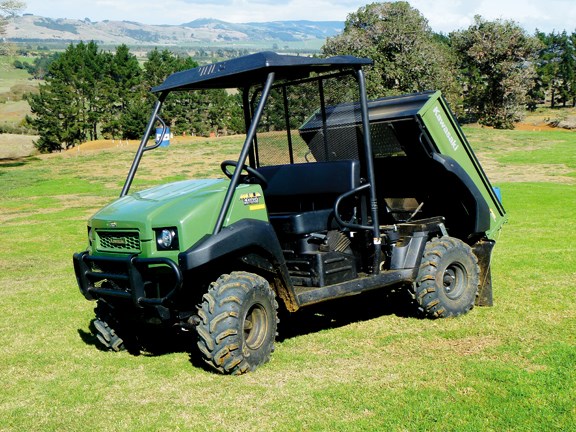 The tray can be manually tipped to unload
The tray can be manually tipped to unload 
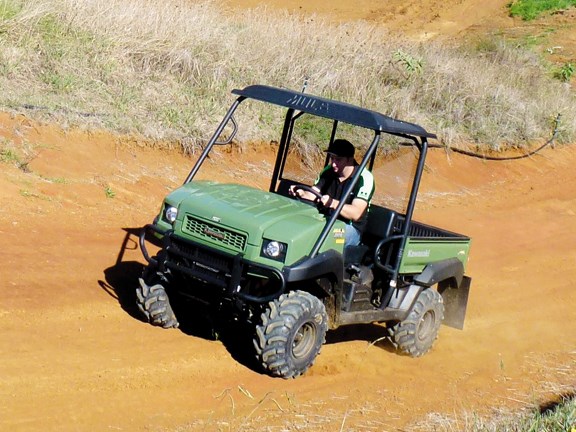 Whilst it may not have the quickest acceleration, the diesel Mule from Kawasaki just keeps climbing up the steeper slopes under the right conditions
Whilst it may not have the quickest acceleration, the diesel Mule from Kawasaki just keeps climbing up the steeper slopes under the right conditions 
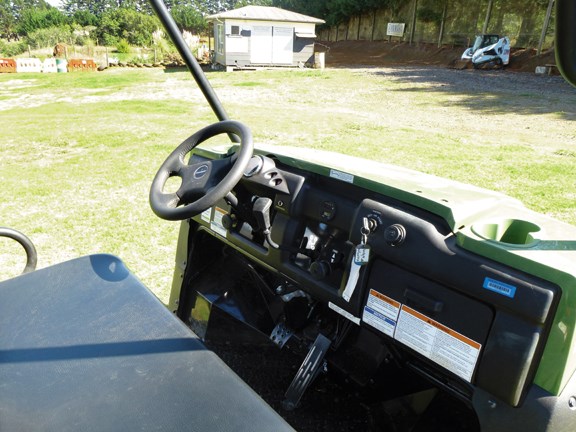 The dash and controls are well laid out and there's loads of room for storage in the sides and under the bonnet
The dash and controls are well laid out and there's loads of room for storage in the sides and under the bonnet 
 A compact economical three-cylinder, 953cc diesel engine provides plenty of power for the Mule
A compact economical three-cylinder, 953cc diesel engine provides plenty of power for the Mule 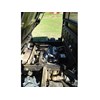
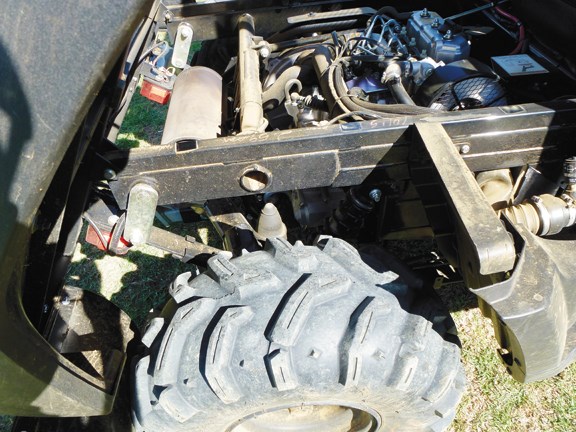 De Dion style suspension in the rear, with a leaf spring and a shock absorber, provides a smooth and stable ride whatever load the Mule is carrying
De Dion style suspension in the rear, with a leaf spring and a shock absorber, provides a smooth and stable ride whatever load the Mule is carrying 
 |
| A bench seat with plenty of room for two people and loads of space for cargo in the back |

 |
| The four-wheel hydraulic drum brakes manage to provide adequate stopping ability on a downhill |
 |
| Great idea: the engine draws in clean air through the tubular steel from the top of the roll frame |

 |
| The tray can be manually tipped to unload |
 |
| Whilst it may not have the quickest acceleration, the diesel Mule from Kawasaki just keeps climbing up the steeper slopes under the right conditions |
 |
| The dash and controls are well laid out and there's loads of room for storage in the sides and under the bonnet |
 |
| A compact economical three-cylinder, 953cc diesel engine provides plenty of power for the Mule |
 |
| De Dion style suspension in the rear, with a leaf spring and a shock absorber, provides a smooth and stable ride whatever load the Mule is carrying |
Brent Lilley discovers the Kawasaki Mule has the characteristics of its four-legged equivalent — it's strong, stable, carries big loads and glides up steep slopes.
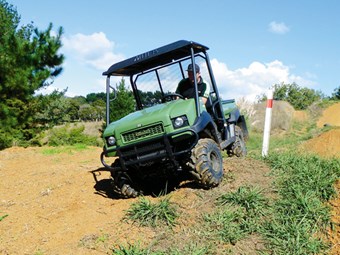 |
| When donkey and horse combine! |
A quick search on the internet for the definition of a mule resulted in some interesting findings. For those of you unaware, a mule is the offspring of a horse and a donkey, possessing the patience, endurance and sure-footedness of the donkey, with the strength and courage of the horse.
After a rigorous test of the Kawasaki Mule 4010, I can confirm this is an accurate description of this utility vehicle.
The location for my tests (three Kawasakis in total) was the Mr Motorcycles Raceway near Tuakau south of Auckland, home to the Pukekohe Motorcycle Club and Motocross in the Auckland region.
This was my first visit to this venue and what a surprise — the property is over 40 acres with multiple motocross tracks and an unused rough area over a variety of challenging terrain proving to be an excellent test site for the machines from Kawasaki. The only thing missing was a bit of mud — a tough ask with the North Island declared a drought zone. I would like to say a big thanks to Scott Wilkins from Kawasaki for organising both the location and the three demo machines courtesy of Mr Motorcylces in Pukekohe. For this issue of Farm Trader I'll be focusing on the Kawasaki Mule 4010 diesel 4x4 and its gruelling day at the motocross track.
Engine
The power for the Mule 4010 diesel comes from a 953cc, four-stroke, three-cylinder diesel engine, which makes up for what it lacks in acceleration with plenty of low rpm torque for strength and endurance when carrying heavy loads or towing. Even though we had nothing available to tow on the test day, it proved its ability when climbing up some fairly steep slopes of the motocross track. As the slope got steeper, the rpm dropped down and it just kept on climbing, losing traction before it lost steam.
Buying a UTV with a diesel engine has its pros and cons and the buyer must weigh these up. On the downside, the engine is much noisier than a petrol one, although still not as loud as some I've driven in the past. It also lacks acceleration, as mentioned earlier. However, these negatives are outweighed by the fact maintenance is simple and servicing and running costs are much lower. But the biggest advantage, particularly on farms and in the construction industry where you have other diesel machines operating, is being able to stick to one fuel type so there's no associated hassles of purchasing and storing petrol.
Like most diesels, the engine is liquid-cooled with a good size radiator in the front to insure the optimum operating temperature while either working hard or idling for extended periods. A great feature of the engine was the cyclone air cleaner drawing in air from a snorkel in the top of the tubular steel roll frame, insuring clean air whatever the conditions. A large 24-litre plastic fuel tank under the seat will keep the economical Mule going for many hours.
Transmission
The transmission is a continuously-variable, belt-driven transmission with selectable high, low, neutral and reverse. The transmission uses a system with a cover and seals to keep mud and water out. Like the engine, the transmission uses the tubular steel roll frame to draw in clean filtered air from above to cool the transmission and reduce wear. I'm a fan of the CVT transmission, although my usual complaint, arising again here with the Kawasaki, is the lack of engine braking. Although not the end of the world, as the Mule has excellent brakes, I still find it unnerving when something I'm driving starts to free wheel downhill. When I query Wilkins from Kawasaki about this, he says Kiwi farmers tend to use these machines in steeper situations than the rest of the world, so engine braking is less valued. Maybe this is something to feature in future models?
When the gear lever is set to high, according to Kawasaki, the Mule gives a top speed of 40km/h. I managed about 36km/h on a flat section of the track fairly easily, although as with most diesels, acceleration isn't a strong point. When in low gear, the machine had good control on steeper ground and, although I didn't have the opportunity to test it with a trailer, I'm pretty certain it'd be ideal for towing.
Suspension and drive
The front suspension features the highly popular independent MacPherson struts mounted on a single A-arm. In the rear there is a De Dion overload-style set up using a leaf spring with a shock absorber. This is the first time I've tested anything with this type of system, which is brilliant for carrying heavier loads while maintaining a smooth ride, loaded or not. On the test day we managed to find some rough terrain and I was really impressed with how the front independent suspension allows the front wheels to climb over ruts and obstacles, while the rear suspension gives an excellent sure-footed feel — just like a Mule should.
Four-wheel drive is selectable from the cab and a limited slip differential is used in the front with booted drive shafts out to the wheels. The rear differential when unlocked will minimise damage to turf when turning, or it can be locked to get yourself out of a sticky situation. Luckily for the guys who washed the Mule at the end of the day, I never managed to find any mud to test this feature.
The brakes are a fairly important item and the Mule uses hydraulic drum brakes all round, with a mechanical linkage to the rear drum from the handbrake. I was initially sceptical of the brakes, firstly because I was expecting to see disc brakes — and secondly because of the ability to carry and tow heavy loads with no engine braking. Not to worry — the responsiveness and stopping ability of the drum brakes shunned any concerns I had, especially when testing them at speed on a steep downhill I nearly threw us out the front and over the bonnet.
Controls and layout
The layout in the cab is good with a flat walk-through floor platform and a comfortable bench seat easily seating two people safely with seatbelts. Although the seat is not adjustable, it is in a good position and all the controls are within easy reach of the driver. The dash includes a speedometer, hour meter, some warning lights and a handy 12-volt socket. There are some useful storage compartments on either side of the dash and another massive storage box under the front bonnet. The Mule on the test day was fitted with an optional plastic roof, worthwhile for some shelter from the elements.
Power steering
All new 2013-model Mules now feature electric power steering as standard. When the steering wheel is turned an electronic signal is sent to the ECU (Electronic Control Unit) which then uses input from the vehicles speed and torque sensors to determine the amount of steering assistance required, so providing the most assistance when moving slowly or stopped and providing less assistance as the forward speed increases. This has multiple benefits as it acts as a damper on rough ground for better control and it doesn't rely on oil pumped from the engine, so there's no power loss. Because it's electronic, it will function with the engine off and the key in the 'on' position.
Rear tray
The sides and tailgate of the rear tray are built out of pressed steel for extra strength. The tailgate opens with two latches and folds down level with the floor of the tray for longer loads. It can be tipped manually by unlocking two locks behind the seat. The tray of the test machine was fitted with an optional tuff deck plastic liner, another good idea to stop the tray getting knocked around. With a load capacity of 499kg, it's right up there with most other makes on the market and should be able to handle most things you require moved.
Manufacturer says
Kawasaki Mule utility vehicles offer high dependability and superb off-road performance, with incredible flexibility and rugged good looks to make them the partner of choice for farms, industrial sites, and many other applications. With new styling and a host of new features, including electric power steering, the latest Mule 4000 series marks the next step in the Mule concept.
Enabling fuel compatibility amongst workplace machines, Kawasaki's diesel Mules are well suited for use in environments where diesel is the primary fuel, such as agriculture, mining, factories and construction sites. The hardy Mule 4010 diesel 4x4 represents a practical choice for more traditional utility vehicle users who simply wish to opt for the lower operating costs, durability and reliability diesel-powered vehicles offer.
Price
At a recommended retail price of $21,395 plus GST, the Kawasaki Mule 4010 4x4 diesel is of similar pricing to most diesel UTVs on the market.
Verdict
Kawasaki has stuck with the Mule concept for quite some time now and seems to be continually improving its design and building on its reputation as being built to last. In my humble opinion, the Kawasaki Mule is one of the better options available in the UTV market at the moment, particularly for use on farms. My only real gripe is the lack of engine braking but, as I mentioned, it's not the end of the world as the four-wheel drum braking is more than capable of stopping the machine when required. The mule has many great features but the three real stand-outs for me are: the electronic power steering; the air intake snorkel on the roll frame; and the low down torque this three-cylinder diesel produces to keep climbing up the steepest slopes. Make sure to keep an eye out for my test of the smaller, sportier petrol Mule 610 XC in next month's issue of Farm Trader.
Highs
- Easily maintained, low-cost diesel engine
- Safely carries two people
- Wide wheelbase and suspension set up gives good stability
- Huge load bed with a high capacity\
Lows
- Lacks acceleration
- Diesel engine is noisier than petrol
- No engine braking
| Specifications | |
| Kawaksaki Mule 4010 diesel 4x4 | |
| Engine | 953cc, four-stroke, three-cylinder, liquid-cooled diesel |
| Max power | 17.7kW (24hp) |
| Fuel capacity | 24L |
| Transmission | Continuously-variable belt drive with low, high, neutral and reverse |
| Drive system | Shaft-driven selectable four-wheel drive with rear differential lock |
| Brakes | Front/rear hydraulic drum |
| Suspension | Front: independent MacPherson struts. Rear: De Dion leaf spring and shock absorber |
| Tyres | Front 23 x 11-10, rear 23 x 11-10 |
| Wheelbase | 1870mm |
| Length | 2965mm |
| Width | 1575mm |
| Height | 1925mm |
| Weight | 732kg |
| Towing capacity | 740kg |
| Cargo capacity | 499kg |
| Rear tray | 1175 x 1310 x 290mm |
| Others in its class | |
| Kubota RTV900 | |
| Kioti Mechron 2200 | |
| Polaris Ranger | |
For the latest reviews, subscribe to our Farm Trader magazine here.
Keep up to date in the industry by signing up to Farm Trader's free newsletter or liking us on Facebook
Source: https://www.farmtrader.co.nz/reviews/1305/kawasaki-mule-4010-diesel-4x4


0 Komentar